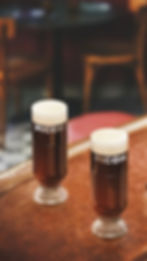Sips Before Supper: Exploring Europe’s Aperitif Traditions”
- Andrei Talapanescu
- Jul 6
- 6 min read
Aperitif Across Europe: A Ritual in a Glass
Before the first bite, there is a sip. Across cultures, countries, and centuries, the aperitif stands as a delicious pause: a moment of unwinding, socialising, and readying the senses for the meal ahead. More than just a drink, the aperitif is a ritual, a cultural gesture, often shared among friends and family, that quietly says: "The day is done, let the evening begin."
While the core idea remains consistent, a light, appetite-stimulating drink enjoyed before dinner, the ingredients, traditions, and style vary beautifully from place to place. From Italy's vibrant spritz culture to the Dutch habit of pairing jenever with a beer, each nation brings its own terroir and tastes to the glass.
Let’s explore the aperitif landscape country by country, from iconic cocktails to humble regional rituals.

Italy
Aperitif Culture: In Italy, the aperitivo is a deeply rooted tradition, a social occasion that often begins around sunset. It is a time to meet friends, unwind, and ease into the evening with something light and refreshing. Bars and cafés across cities like Milan, Rome, and Venice offer aperitivo hours where drinks are served with small complimentary bites known as "cicchetti" or "stuzzichini."
Aperitif Style: Sociable, colorful, and often bitter-forward. Italian aperitifs typically feature low-ABV liqueurs and amaros, sparkling wines, and generous amounts of ice, frequently accompanied by snacks that balance salt, fat, and acidity.
Popular Serves:
Spritz Veneziano (Aperol Spritz): Aperol + Prosecco + soda
Negroni: Gin + Campari + Sweet Vermouth
Americano: Campari + Sweet Vermouth + soda
Cynar Spritz: Cynar + Prosecco + soda + olive
Sgroppino: Lemon sorbet + vodka + Prosecco
Limoncello Spritz: Limoncello + Prosecco + soda
Bellini: White peach purée + Prosecco
Produce / Products:
Aperol, Campari, Cynar, Limoncello, Prosecco, Carpano Antica Formula, Cocchi Vermouth,
Olives, citrus, almonds, prosciutto, taralli, focaccia, grissini

Spain
Aperitif Culture: In Spain, the aperitivo is a sacred pre-lunch or pre-dinner hour, especially during weekends. It’s often enjoyed at a terrace or tapas bar with a drink in hand and a small plate of something salty, vinegary, or preserved—perfect for whetting the appetite. Vermouth culture is particularly strong, with house-made versions poured over ice and garnished with citrus or olives.
Aperitif Style: Bright, wine-based, and often carbonated. Spanish aperitifs balance bitter, sweet, and herbal profiles and frequently include fortified wines or local liqueurs.

Popular Serves:
Vermut con Sifón: Spanish vermouth + soda
Tinto de Verano: Red wine + lemon soda
Rebujito: Fino sherry + lemon-lime soda + mint
Kalimoxto: Red wine + Coca-Cola
Carajillo: Espresso + brandy or Licor 43
Produce / Products:
Yzaguirre, Casa Mariol, Lustau sherries, Licor 43, Cava, Manzanilla
Gordal olives, piparras (pickled peppers), jamón, marcona almonds, canned mussels, anchovies
France
Aperitif Culture: The French aperitif is a more formalized ritual, typically marking the transition from the workday to the dinner hour. It’s a moment of elegance and restraint—drinks are sipped slowly and paired with small, refined bites. In the south, anise-based spirits dominate; in Paris and the north, vermouths and sparkling wines take center stage.
Aperitif Style: Refined and rooted in aromatized wines, bitters, and subtle liqueurs. French aperitifs emphasize balance and restraint with a touch of sophistication.
Popular Serves:
Kir / Kir Royal: White wine or Champagne + crème de cassis
Pastis: Anise liqueur + water
Suze & Tonic: Gentian liqueur + tonic
Dubonnet Rouge: Dubonnet + gin + lemon
Cardinal: Red wine + crème de cassis
French 75: Gin + lemon + sugar + Champagne
Champagne Cocktail: Sugar cube + bitters + Champagne
Produce / Products:
Suze, Byrrh, Lillet Blanc/Rouge, Noilly Prat, Ricard, Dubonnet
Radishes with butter and salt, cheese gougères, olives, tapenade, saucisson

Belgium
Aperitif Culture: Belgium’s aperitif traditions are influenced by both its beer heritage and its French-speaking regions. In many cafés, locals enjoy a special beer or a low-ABV bitter liqueur with small snacks like cheese or charcuterie. Jenever is often served neat, and occasionally followed by a beer.
Aperitif Style: Beer-focused with regional herbal and bitter liqueurs. Belgian aperitifs favor balance between richness and sharp refreshment.

Popular Serves:
Gueuze / Lambic Beers: Spontaneously fermented tart beers
Picon Bierre: Pilsner + bitter orange liqueur
Fruit Beers: Kriek, Framboise, etc.
Jenever + Pickle Back: Neat Jenever + brine or beer chaser
Produce / Products:
Picon, Jenever, Kriek, Chimay, Boon lambics, Trappist ales
Cheese (Herve, Chimay), pickled onions, gherkins, charcuterie, bitterballen
Switzerland
Aperitif Culture: In Switzerland, the aperitif bridges Alpine tradition and cosmopolitan influence. Locals gather for pre-dinner drinks at home or in cafés, often accompanied by air-dried meats, cheese, and bread. Clear fruit brandies are enjoyed in rural areas, while modern bars lean into herbal vermouths and aromatized wines.
Aperitif Style: Alpine, herbal, and driven by fruit brandies and fortified wines. Swiss aperitifs favor freshness and herbal complexity.
Popular Serves:
Schnapps / Obstler: Clear fruit brandies (pear, apple)
Swiss Vermouth Spritz: Dry vermouth + soda + lemon
Williams Pear with Ice: Pear eau-de-vie over ice
Grapefruit + Swiss Vermouth + Herbs: Dry vermouth + grapefruit soda + sage/thyme
Produce / Products:
Morand Poire Williams, Etter Zwetschge, La Valote dry vermouth
Gruyère, Bündnerfleisch, rye bread, pickled radish, apricot preserves

Austria
Aperitif Culture: In Austria, the aperitif is often about relaxed elegance—white wine spritzers dominate the scene, especially in wine-producing regions like the Wachau. Aperitif drinks are commonly enjoyed in cafés or heuriger (wine taverns) with cold cuts, cheeses, and vegetable spreads.
Aperitif Style: Light wines and regional herbal sodas. Austrian aperitifs emphasize crispness and minerality with subtle herbal touches.

Popular Serves:
Gespritzter (Spritzer): Grüner Veltliner + sparkling water
Almdudler & Vodka: Alpine herbal lemonade + vodka
Maria Theresia: Coffee + orange liqueur + whipped cream
Produce / Products:
Grüner Veltliner, Almdudler, pumpkin seed oil (Kürbiskernöl)
Smoked ham, pickled vegetables, rye crisps, Liptauer cheese spread
Netherlands
Aperitif Culture: The Dutch tradition of borrelen (drinks and bites) embraces simple yet bold flavors. Aperitifs are enjoyed before dinner or during early evening gatherings. Jenever is a staple spirit, often accompanied by beer and savory snacks like bitterballen or cheese.
Aperitif Style: Genever-centric with strong beer culture; growing interest in botanical drinks and modern vermouths. Dutch aperitifs tend to be hearty, aromatic, and approachable.
Popular Serves:
Kopstootje: Genever + beer chaser
Dutch Vermouth & Tonic: Willem's Wermoed + tonic + grapefruit
Gin & Tonic: Spanish-style service, widely adopted with local gin brands
Produce / Products:
Bols Genever, Rutte, Willem's Wermoed, Vyr Vermouth
Gouda, Leyden cheese, smoked eel, pickled onions, bitterballen

Germany
Aperitif Culture: Germany's pre-meal drinks tend to be refreshing and modest in strength, often consumed in beer gardens, patios, or at home. Wine spritzers and herbal bitters dominate, especially in warmer months. Food pairings are rooted in rustic tradition—salty, savory, and satisfying.
Aperitif Style: Wine spritzers, bitter liqueurs, and regional herbal schnapps. German aperitifs emphasize crispness, herbal notes, and balance.

Popular Serves:
Weißweinschorle: Dry white wine + sparkling water
Underberg & Soda: German herbal bitter + soda + lemon
Gin & It: Gin + sweet vermouth (popular in urban cocktail bars)
Produce / Products:
Riesling, Silvaner, Underberg, Jägermeister
Radishes, pretzels, Obatzda cheese spread, liverwurst, pickles
Portugal
Aperitif Culture: In Portugal, the aperitif (aperitivo) is a relaxed but cherished ritual. Fortified wines like port or Madeira are often served with almonds, olives, or cured meats. In urban areas, newer drinks like the Portonic have gained popularity as light, citrusy alternatives.
Aperitif Style: Fortified wines, tonic spritzes, and fruit-forward liqueurs. Portuguese aperitifs balance complexity with sunny drinkability.
Popular Serves:
Ginjinha (Ginja): Sour cherry liqueur in a shot glass
Portonic: White port + tonic + citrus
Madeira & Tonic: Dry Madeira + tonic + lemon
Produce / Products:
Niepoort white port, Ginja Eduardino, Blandy’s Madeira
Salted almonds, Serra cheese, chouriço, olives, sardines in olive oil

Other Classic Aperitif Staples
In addition to regional specialties, some classic cocktails or mixed drinks transcend borders and have become staples of aperitif menus around the world. Drinks like the Gin & Tonic, originally rooted in colonial India and embraced strongly in Spain and the Netherlands, have evolved into highly customizable experiences with local gins and garnishes. The Martini, Pink Gin, and Gimlet reflect a British influence, offering strong, aromatic, and bracing profiles that prepare the palate. The Gin and It—a mix of gin and Italian vermouth—offers a softer, more rounded alternative to a dry Martini, while the French 75 and Champagne Cocktail embody the celebratory elegance of sparkling aperitifs.
Other notable additions include the Death in the Afternoon, a dramatic blend of absinthe and Champagne credited to Ernest Hemingway; the Campari Shakerato, a simple but intense Italian aperitif made by shaking Campari with ice until frothy; and the Bicicletta, a northern Italian mix of white wine and Campari served over ice. The Pimm’s Cup, deeply British and full of fruit and herbs, fits perfectly into garden party aperitif culture. Lastly, the Shandy—beer mixed with citrus soda or lemonade—is a refreshing low-alcohol aperitif popular in Germany, the UK, and beyond.
Closing Note
From the vineyards of Porto to the rooftops of Rome, the aperitif endures as both a drink and a tradition. Whether you're sipping a Portonic in Lisbon or stirring a Negroni in Milan, these drinks carry not only flavor but history, terroir, and a shared moment of pause.
Aperitif is not a drink. It’s a rhythm and a moment.
.png)




















